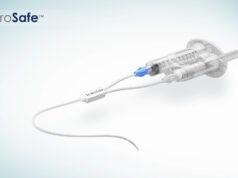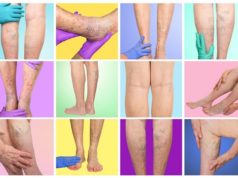 Preliminary data from the Fovelass trial, presented at the Charing Cross Symposium (24–27 April, London, UK) by Claudine Hamel-Desnos (Caen, France) show that at one-year follow-up, the rate of occlusion of the small saphenous vein is lower after ultrasound guided foam sclerotherapy than after endovenous laser ablation, but the clinical improvement is similar in both groups and remains stable.
Preliminary data from the Fovelass trial, presented at the Charing Cross Symposium (24–27 April, London, UK) by Claudine Hamel-Desnos (Caen, France) show that at one-year follow-up, the rate of occlusion of the small saphenous vein is lower after ultrasound guided foam sclerotherapy than after endovenous laser ablation, but the clinical improvement is similar in both groups and remains stable.
This is the first result of the Fovelass study: A multicentre, randomised, controlled study comparing endovenous laser ablation and ultrasound guided foam sclerotherapy regarding the rate of occlusion in the small saphenous vein, eventually with a three-year follow-up. The study is ongoing.
Data from 158 patients, at 12 centres, were included in the study of which 78 underwent ablation, and 80 had sclerotherapy. Both groups were homogenous: 75% female, mean age 58. There were no significant anatomical differences of the small saphenous vein between ablation and sclerotherapy patients (the mean diameter at mid-calf was 6mm and 5.8mm respectively).
Duplex ultrasound data eight days postoperatively show that both the ablation and the sclerotherapy groups have complete occlusion of the small saphenous vein. However, at the one-year follow-up, there was a significant difference between the level of occlusion of the small saphenous vein in the two patient groups. The ablation group had a relatively high degree of occlusion, at 95.2%, whereas the average small saphenous vein occlusion for the sclerotherapy group after one year is 60%.
Hamel-Desnos and colleagues also conducted a literature review and meta-analysis. The duplex ultrasound data showed that the ultrasound-guided sclerotherapy group for segmental occlusion at day eight had had a main occlusion length of 15cm. At six months, the main occlusion length was 16cm and at one year the occlusion length was 14.8cm. At one year, the mean diameter of the ultrasound-guided sclerotherapy recanalisation group was 1.9mm.
“On day eight, the rate of occlusion was very high,” said Hamel-Desnos. She continued, “It was more than 90% for both groups. However, at one year, the rate of occlusion was 96% for laser, but only 60% for foam.”
The length of vein occlusion for complete occlusion was about 20cm for both groups, though a little greater for ultrasound guided foam sclerotherapy.
“For foam, in the case of a segmental occlusion, the mean length of occlusion was about 15cm which is not so bad. Also we have noticed that in the case of recanalisation, the mean diameter was only 1.9 mm at one year,” Hamel-Desno said.
The diameter of the vein diminished quicker in the laser group than in the foam group and almost all patients were symptomatic at day zero. Conversely, 80% of these patients were asymptomatic at one year.
The validation of venous clinical severity score (VVSS) score was highly improved in both groups, with no difference even at one year. The quality of life scores were improved at six months and remained stable at one year for both groups with no difference between them.
“A complementary sclerotherapy was carried out in just a few cases, while no phlebectomy was performed and at one year, varicose veins in the small saphenous vein region were much less frequent than on day zero,” added Hamel-Desno.
Hamel-Desnos concluded: “Our preliminary results show that at one-year follow-up, the rate of occlusion of the small saphenous vein is lower after foam than after laser but the clinical improvement is similar in both groups and remains stable.”









